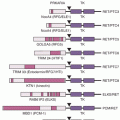




R E F E R E N C E S
1. Powell RG, Weisleder D, Smith CR, et al. Antitumor alkaloids from Cephalotaxus harringtonia structure and activity. J Pharm Sci 1972;61:1227–1230.
2. Huang MT. Harringtonine, an inhibitor of initiation of protein biosynthesis. Mol Pharmacol 1975;11:511–519.
3. Baaske DM, Heinstein P. Cytotoxicity and cell cycle specificity of homoharrintonine. Antimicrob Agents Chemother 1977;12:298–300.
4. Savaraj N, Lu K, Dimery I, et al. Clinical pharmacology of homoharringtonine. Cancer Treat Rep 1986;70:1403–1407.
5. Neidhart JA, Young DC, Derocher D, et al. Phase I trial of homoharringtonine. Cancer Treat Rep 1983;67:801–804.
6. Grem JL, Cheson BD, King SA, et al. Cephalotoxine esters: antileukemic advance of therapeutic failure. J Natl Cancer Inst 1988;80:1095–1103.
7. O’Brien S, Kantarjian H, Keating M, et al. Homoharringtonine therapy indices responses in patients with chronic myelogenous leukemia in late chronic phase. Blood 1995;86:3322–3326.
8. Legros L, Hayette S, Nicolini FE, et al. BCR-ABL(T315I) transcript disappearance in an imatinib-resistant CML patient treated with homoharringtonine: a new therapeutic challenge? Leukemia 2007;21(10):2204–2206.
9. Jorge Cortes J, Lipton JF, Rea D, et al. Phase 2 study of subcutaneous omacetaxine mepesuccinate after TKI failure in patients with chronic-phase CML with T315I mutation. Blood 2012;120:2573–2580.
10. Labrou NE, Papageorgiou AC, Avramis VI. Structure-function relationships and clinical applications of L-Asparaginases. Curr Med Chem 2010;17:2183–2195.
11. Verma N, Kumar K, Kaur G, et al. L-Asparaginase: a promising chemotherapeutic agent. Crit Rev Biotechnol 2007;27:45–62.
12. Zeidan A, Wang ES, Wetzler M. Pegasparaginase: where do we stand? Expert Opin Biol Ther 2009;9:111–119.
13. Avramis VI, Panosyan EH. Pharmacokinetic/pharmacodynamic relationships of asparaginase formulations: the past, the present and recommendations for the future. Clin Pharmacokinet 2005;44:367–393.
14. Appel IM, Hop WC, Pieters R. Changes in hypercoagulability by asparaginase: a randomized study between two asparaginases. Blood Coagul Fibrinolysis 2006;17:139–146.
15. Evans WE, Yee GC, Crom WR, et al. Clinical pharmacology of bleomycin and cisplatin. Head Neck Surg 1981;4:98–110.
16. Chen J, Stubbe J. Bleomycins: towards better therapeutics. Nat Rev Cancer 2005;2:102–112.
17. Hecht SM. Bleomycin: new perspectives on the mechanism of action. J Nat Prod 2000;63:158–168.
18. Lewis TG, Nydorf ED. Intralesional bleomycin for warts: a review. J Drugs Dermatol 2006;5:499–504.
19. Shaw P, Agarwal R. Pleurodesis for malignant pleural effusions. Cochrane Database Syst Rev 2004;(1):CD002916.
20. Good LM, Miller MD, High WA. Intralesional agents in the management of cutaneous malignancy: a review. J Am Acad Dermatol 2011;64:413–422
21. Kawai K, Akaza H. Bleomycin-induced pulmonary toxicity in chemotherapy for testicular cancer. Expert Opin Drug Saf 2003;2:587–596.
22. Azulay E, Herigault S, Levame M, et al. Effect of granulocyte colony-stimulating factor on bleomycin-induced acute lung injury and pulmonary fibrosis. Crit Care Med 2003;31:1442–1448.
Stay updated, free articles. Join our Telegram channel

Full access? Get Clinical Tree








